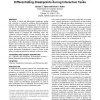Free Online Productivity Tools
i2Speak
i2Symbol
i2OCR
iTex2Img
iWeb2Print
iWeb2Shot
i2Type
iPdf2Split
iPdf2Merge
i2Bopomofo
i2Arabic
i2Style
i2Image
i2PDF
iLatex2Rtf
Sci2ools
CHI
2007
ACM
2007
ACM
Understanding and developing models for detecting and differentiating breakpoints during interactive tasks
The ability to detect and differentiate breakpoints during task execution is critical for enabling defer-to-breakpoint policies within interruption management. In this work, we examine the feasibility of building statistical models that can detect and differentiate three granularities (types) of perceptually meaningful breakpoints during task execution, without having to recognize the underlying tasks. We collected ecological samples of task execution data, and asked observers to review the interaction in the collected videos and identify any perceived breakpoints and their type. Statistical methods were applied to learn models that map features of the interaction to each type of breakpoint. Results showed that the models were able to detect and differentiate breakpoints with reasonably high accuracy across tasks. Among many uses, our resulting models can enable interruption management systems to better realize defer-to-breakpoint policies for interactive, free-form tasks. CATEGORIES ...
CHI 2007 | Human Computer Interaction | Meaningful Breakpoints | Task Execution | Task Execution Data |
Related Content
| Added | 30 Nov 2009 |
| Updated | 30 Nov 2009 |
| Type | Conference |
| Year | 2007 |
| Where | CHI |
| Authors | Shamsi T. Iqbal, Brian P. Bailey |
Comments (0)

